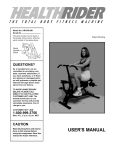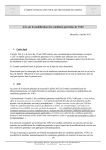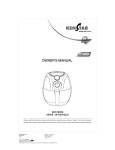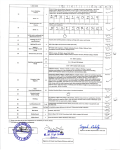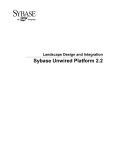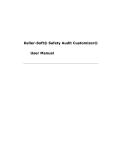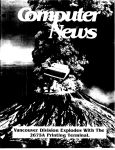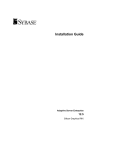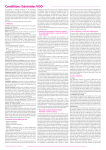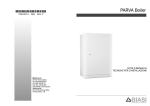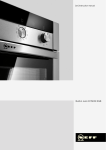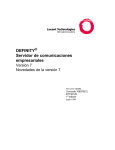Download SERVICE MANUAL - newagemetal.com
Transcript
Bulletin 9D-7 August, 1951 Second P~inting Model "BB" Page I Model "BB" Carburetor SERVICE MANUAL UNITED MOTORS SERVICE -AC DIVISION General Motors Products of Canada, Limited OSHAWA - ONTARIO Bullerin 9D-7 Aueusr. 1951 ~ o d e "l B B Page 2 COPYRIGHT 1951 Bulletin 9D-7 Auausr. 1951 Model "BB" Page 3 7 . r FIGURE 1. MODEL " B B CARBURETOR The new Rochester Model "BB" Carburetor incorporates a number of distinct features. Foremost of these features is the concentric float bowl, which completely encompasses the main bore of the carburetor. This float bowl concentricity in conjunction with the centrally located main discharge nozzles, prevents fuel loss on road inclines. Regardless of the angle the car may assume, the fuel level is a t all times below the nozzle spill point. A second feature of the model "BB" carburetor is the design of t h e Main Well Assembly. This assembly contains the Main Metering Jets and the Power Valve. It is attached t o the carburetor air horn and suspended in the float bowl. Due t o t h i s suspension of the main well in the fuel bowl, engine heat cannot be directly transmitted to the main passageways through the Main Metering Jets. The model "BB" carburetor incorporates the conventional six systems of carburetion; Idle, P a r t Throttle, Power, Accelerator Pump, Float, and Choke. Each of the systems is basically simple and can readily be traced and understood. PERFORMANCE FEATURES F The model "BB" Carburetor, by metering a continuous fuel flow to the engine, gives smoother performance a t all speeds. The continuous fuel flow to the engine is accomplished by having the idle and main metering systems flow through common passages. This eliminates t h e transfer point, or point a t which the idle fuel changes flow direction, a condition common t o carburetors with separate idle and main well systems. It is often advantageous t o operate the engine with full power mixtures without advancing the accelerator to the full wide-open Bulletin 9D-7 August, 1951 Model "BB" Page 4 position. By the use of the vacuum operated power system in the new carburetor, these power mixtures a r e readily available. This is due to the ability of the power valve to function a t any drop in manifold vacuum below approximately 7" Hg., regardless of the degree of throttle opening. In carburetors which employ a mechanically operated power system, the throttle must be advanced to almost full wide open position to obtain the power mixtures. For good initial acceleration and to minimize hard starting in hot weather, the model "BB" unit employs a vented type of pump plunger. U7hen the engine is not operating, the rise in heat from the engine manifold causes the fuel in the pump system to boil. The increased pressure from this boiling in conventional units often times forces the fuel from the pump system into the engine. The new type carburetor has a ball type check valve built into the plunger head. As a consequence, any fuel boiling below t h e pump plunger, is automatically vented by t h e ball check into the float bowl. This system always provides solid fuel in the pump chamber for smooth acceleration under relatively high temperature operation. SERVICE FEATURES The Model "BB" Carburetor has been designed with simplicity of construction and maximum ease of service. Both the idle tubes and pump jets, being pressed into the air horn and bowl castings respectively a t the factory, need never be replaced or serviced. In many instances the entire unit will not have to be removed from the engine. All of the main metering parts a r e in the air horn assembly. By simply removing the cover screws and disconnecting the heat tuhe, choke arm, and pump rod, i t is posable to service 0;' inspect the floats, float valve assembly, main well support assembly, power valve assembly, and automatic choke assembly. With t h e exception of t h e initial idle adjustment t h e model "BE" carburetor does not require any part throttle or power mixture adjustments. Since carburetion is dependent upon both compression and ignition, the carburetor should always be adjusted last in engine tune-up. .. IDLE SYSTEM At small throttle openings, the vacuum created a t t h e main discharge nozzles is not great enough to cause fuel t o flow out of the nozzles. Therefore, a n additional system has been introduced to provide the relatively rich mixture ratios 'equired throughout t h e idling range. As shown in Figure 2, the idle fuel .--. , , first passes from the bowl through the calibrated main metering jets in .-" <*"em the bottom of the main well suvvort assembly. The fuel is then drawn up is" IDLE SYSE the main well bv manifold vacuum to -. E l om,r* --t h e Air Horn crossbar.. Air is bled into t h e solid fuel a t the calibrated air bleeds above the nozzles. This fuel/air mixture then passes through the calibrated idle tuhe, (additional air entering thru t h e crossbar idle air bleeds) and passes down the passage in the Float Bowl to the Throttle Body. . 8 LE 8 " Bullerin 9D-7 Aupcisc. 1951 h l o d r l "BB" .- Page 5 The idle fuel is then metered to the engine by the idle adjusting needles located below the throttle valves. As the throttle valves are opened, the idle discharge holes above the throttle valves a r e exposed to manifold vacuum, thus becorziing fuel discharge holes to meet the increased demand of the engine PART THROTTLE SYSTEM As the throttle valves are opened to a greater degree, (Figure 3) the suction created a t the main discharge nozzles by means of manifold vacuum and the multiplication created by means of t h e primary and secondary venturi, becomes great enough to pull fuel from the nozzles, through the main metering jets, the main -well channels and t h e crossbar channels. At this point air is bled into this fuel through the crossbar bleeds. The fuel is thus discharged from the main discharge nozzles rather than through the idle system. The calibration of the Main Metering Jets and the Air Bleeds in the crossbar control and maintain the economical fuel/air ratios throughout this part throttle driving range. MODEL"B5 PART THROTTLE SYSTEM Figure 3 POWER SYSTEM Although the part throttle system is calibrated to give maximum economy under normal driving conditions, some means must be provided by which increased fuel is supl~liedwhen more power is desirable or sustained high speed driving is t o be maintained. This is accomplished by means of a vacuum operated power piston. (See Figure 4. Note piston in "Down" position). MODEL "88' POWER SYSTEM Figure 4 The power piston vacuum channel is open t o the manifold beneath the throttle valves. The vacuum in this channel varies with the manifold vacuum. The power piston actuating spring is so calibrated a s t o force the piston down when the manifold vacuum drops helow approximately 7" Hg. This situation occurs a t driving speeds over approximately 7 5 MPH. or on rapid acceleration. When the power piston is down i t unseats the spring loaded power valve permitting a n additional fuel flow from the bowl through the power restrictions and into the main well channels. This additional fuel is supplied a s long a s the manifold vacuum remains below approximately 7 inches Hg. There is no adjustment required for the part throttle or power systems. Bulletin 9D.7 August, 1951 Model "BB" Page 6 FLOAT SYSTEM To aid in maintaining the correct fuel level under all conditions the carburetor employs twin floats. It is of the utmost importance that the floats be adjusted carefully and accurately. (See Figure 5) SEE ADJUSTMENT BULLETIN FOR CORRECT FLOAT SETTING. ACCELERATING PUMP SYSTEM When the throttle is opened suddenly the a i r flow and manifold vacuum change almost instanteously, while the heavier fuel tends to lag behind causing a momentary leanness. The accelerator pump provides the additional fuel necessary for smooth operation on ravid acceleration. (See Figure 6) ; ; ' MODM " B B FLOAT SYSTEM I Figure 5 A double spring pump plunger is used on the model "BB" carburetor. The rates of compression of the top spring versus the bottom spring are calibrated to insure a smooth, sustained charge of fuel for acceleration. On the pump intake stroke, fuel passes through the pump inlet screen, unseats the inlet ball, and fills t h e pump well. The accelerator pump, being connected directly to the throttle, ,, " ~* moves a t t h e slightest change in mo, throttle opening. The force of the pump plunger upon acceleration seats the inlet ball, forces fuel through the outlet channel which unseats the spring loaded outlet ball and then discharges through the pump jets, into the main air stream. t,,"p ", LE E. I mum1 -68" PUMP SYSAM Figure 6 NO TARGETING OF THE PUMP JETS 1s REQUIRED. Bulletin 9D-7 August, 1951 lrlodel "BB" Paae 7 CHOKE SYSTEM The model "BB" carburetor employs a fully automatic choke^ to insure proper starting and driving during cold weather operation. This choke system is composed of a thermostatic coil, piston, choke valve, and fast idle cam linkage. It is controlled by a combination of intake manifold vacuum, the offset choke valve, atmospheric temperaheat. (Figure 7) When the engine is cold the thermostatic coil is calibrated to hold t h e choke valve closed. -- #*lllll*-oil---'--i s . l i s l r ..."*"'"""II r x e "s*'v' # V * ' iI : t L ,. . .* ; MOOR "'$0" CHOKi SYS Figure 7 As the engine is started, air velocity against the offset choke valve causes the valve to open slightly against t h e torque of the thermostatic coil. In addition, intake manifold vacuum is applied to the choke piston which also tends to pull the choke valve open. As a consequence t h e choke valve assumes a position where t h e torque of t h e thermostatic coil is balanced against vacuum pull upon the choke piston and air velocity against the offset choke valve, thereby causing a regulated air flow into the carburetor which provides a richer mixture during the warm-up period. During warm-up, the Choke piston serves to modify the choking action to compensate for varying engine loads or acceleration. Any acceleration or increased road load decreases the vacuum exerted on the choke piston. This allows the thermostatic coil torque to momentarily increase choke valve closure to provide the engine with a sufficiently richer mixture for acceleration. As the engine warms up, hot air from the exhaust manifold "stove" is drawn into the thermostatic coil housing. This hot air causes a rise in temperature which causes the coil t o slowly relax its tension. Thus the choke valve is allowed to move gradually to the full open position as the engine warms up. To prevent stalling during the warm-up period, i t is necessary to run the engine a t a slightly higher idle speed than for a warm engine. This is accomplished by the fast idle cam which is linked to the choke valve shaft and holds the throttle valve open sufficiently during the warm-up period t o give the increased idle RPM, until such time as the choke valve moves to the full open position. While the automatic choke is in operation, the driver may wish to advance the throttle to the full wide open position. Since this would decrease vacuum pull upon the choke piston thereby closing the choke valve, i t is necessary to provide increased carburetor air flow by opening the choke valve mechanically. Bullerin 90-7 August, 1951 Model '88'' Page 8 To accomplish this, a tang on the throttle lever is made to contact the fast idle cam linkage a t wide upon throttle position so as to sufficiently open the choke valve. This is also called a choke unloader and serves to dechoke a flooded carburetor during cold starting operation. This choke unloader will also relieve a flooded condition on starting by allowing more air to enter the carburetor and mix with the excess gasoline in the manifold whenever the engine is cranked with the accelerator held fully depressed. CHOKE MODIFIER Thechokesystem.aSused on some ~ o d e l"BB" Carburetors, also incorporates a choke modifier. -w-~m'"""":;;;:-r~"""" E l r r a . xP r- ,* ;X ;* * ~ ~ ~ * ~ " * " " , , , l ?'"'"''-*.~---', ,..*' ;, The purpose of the "BB" choke modifier, as required by certain engines, is to prevent "loading up" or excessively rich mixtures during the warm-up period. Under normal operating conditions, the automatic choke assumes a position where the torque of the thermostatic coil is balanced against the vaCHOKE MOI cuum pull on the choke piston plus the air velocity against Flgure 8 the offset choke valve. As the heat from the exhaust manifold relaxes the tension on the thermostatic coil, the choke valve gradually opens. 8 , - ?, When the engine is started cold and the throttle is opened considerably (such as in going up a steep hill), vacuum drawing heat to the coil may not be sufficient to heat and relax the coil before some "loading up" takes place. The choke modifier, being linked directly to the throttle, (Figure 8) is actuated by this throttle movement. It in turn rotates the thermostatic coil, thus relaxing the tension on the coil and allowing the choke valve to open sufficiently to prevent "loading up". Bulletin 9D-7 August. 1951 hlodel "BB" Page 9 DISASSEMBLY OF MODEL "BB" CARBURETOR CHOKE DISASSEMBLY 1. Loosen %'' brass fitting on choke suction tube 2. Remove three attaching choke cover screws and retainers, then remove choke cover, Cover Gasket, and Thermostatic Coil assembly from choke housing, 3. Remove Baffle plate. 4. Remove cotter pins from each end of choke rod and remove rod. 5. Remove retaining screw a t end of choke shaft and carefully pry off choke trip lever, spacing washer, and choke counter weight. 6. Remove two choke valve screws and then remove choke valve. 7. Rotate choke shaft counter clockwise to free choke piston from housing and then remove piston and choke shaft from carburetor. 8. Remove choke piston pin and piston from choke shaft. 9. Remove two choke housing attaching screws. Choke housing and gasket may now be removed from Air Horn. AIR HORN 1. Remove filter screen retainer nut and gasket with 3/4" wrench and remove filter screen. 2. Remove clip on upper end of pump rod and cotter pin on bottom. Remove pump rod from rocker arm. 3. Remove cotter pins from center and end of rocker arm and remove rocker arm and spacing washer from Air Horn. 4. With carburetor upended on a flat surface, remove four Air Horn screws. 5 . With carburetor again in an upright position, remove remaining four Air Horn screws and lift Air Horn gently from bowl. (If necessary, lightly tap sides of Air Horn to break the gasket seal.) 6. Place Air Horn upended on a flat surface. Remove float hinge pin and lift float assembly from Air Horn. 7. Press rubber seal on pump plunger arm through Air Horn and remove both the seal and the pump plunger. Then separate pump plunger and the rubber seal. 8. Remove float needle seat and gasket with a %'' bit screwdriver. 9. Remove main metering jets from main well support. NOTE: I t is not necessary to remove power valve assembly. 10. Loosen two screws and remove main well support. Air Horn gasket may now be removed. 11. Remove power piston and actuating spring. 12. Loosen screw and remove secondary venturii cluster. 13. Carfully remove float balance spring and clips. 14. Remove retaining clip and pump vent disc from Air Horn. August. hlodel 1951 "BB Page 10 BOWL DISASSEMBLY 1. Remove pump return spring and intake ball from pump well. NOTE: Hold pump outlet guide while removing inlet ball. 2. Carefully remove pump screen from bowl. 3. Invert the bowl and remove pump discharge spring guide, spring, and ball. 4. Upend carburetor bowl (be careful to let the heat tube hang over the end of the flat surface) and remove four throttle body attaching screws. The throttle body and gasket may now be removed. THROTTLE BODY DISASSEMBLY 1. Remove idle adjusting needles and springs. 2. Remove idle and fast idle screws from throttle lever. NOTE: Do not remove throttle valves from throttle body. Due to the close tolerance fit of the throttle valve, and the fact that the idle discharge holes are drilled in relation to the throttle valve in the closed position, the throttle body and valve should be replaced as a complete assembly when wear is noted a t the throttle valve, shaft, or throttle body bore. 3. Loosen screw and remove fast idle cam. NOTE: I t is not necessary to remove choke suction tube from throttle body. CLEANING OF PARTS 1. Thoroughly clean carburetor castings and metal parts in carburetor cleaning solvent. CAUTION: Choke coil and housing and pump plunger should not be immersed in solvent. Clean pump plunger in clean gasoline only. 2. Blow all passages in castings dry with compressed air and blow off all parts until they are dry. CAUTION: Do not pass drills or wires through calibrated jets or passages as this may enlarge orifice and seriously affect carburetor calibration. 3. Clean filter screens for dirt or lint. If they are distorted or remain plugged, replace. INSPECTION OF PARTS 1. Check floats for dents or wear a t hinge pin holes. Shake float to check for leaks. Replace if necessary. 2. Examine float needle and seat. If grooved replace with a factory tested and matched float needle, seat and gasket assembly. 3. Check choke shaft for wear in the bores. If worn excessively replace part. 4. If throttle shaft or valves appear loose due to wear, replace throttle body assembly. 5 . Inspect holes in pump and throttle levers. If worn out of round they should be replaced. 6. Inspect idle adjusting needles for burrs or ridges. Replace if necessary. Bulletin 9 D - 7 August, 1951 ,- Model " B B Page 11 7. If wear is noted on steps of fast idle cam, i t should be replaced a s it may upset engine idle speed during t h e choking period. 8. Inspect pump plunger leather. Replace plunger if leather is damaged. 9. If gaskets appear hard or brittle, replace t o insure a proper seal. 10. Check to see t h a t lower end of choke suction tube is tight in seal in throttle body. If not, a new seal will have to be installed after the carburetor has been completely assembled. 11. Inspect suction tube nut packing. If compressed or out of round, replace ASSEMBLY AND ADJUSTMENT IMPORTANT: To prevent poor economy due to fuel leakage all threaded parts must be installed tightly. This applies especially to the strainer nut and float needle seat. 1. 2. 3. 4. THROTTLE BODY ASSEMBLY Install idle screw in throttle lever. Screw Idle adjusting needles and springs into throttle body until they are finger tight. Back out screw 1%turns a s a temporary idle adjustment. Make final adjustment on engine. Install fast idle cam and fast idle screw to throttle lever. Upend bowl, place throttle body gasket in position and attach throttle body. Tighten screws evenly and securely. NOTE: New choke suction tube seal, if needed, will be installed after carburetor is completely assembled. (See Page 15.) BOWL ASSEMBLY 1. With bowl again in upright position, drop small aluminum pump inlet ball into pump well hole and replace pump return spring. 2. Install large steel ball in pump discharge cavity. Place spring and pump discharge guide on top of ball. (Figure 9) 3. Press pump screen carefully into position. AIR HORN ASSEMBLY 1. With Air Horn upended on a flat surface, install float needle seat and gasket, using screwdriver with a %" bit. 2. Place small pump vent disc and retaining clip into pump vent. 3. Place Power Piston spring and Power Piston into vacuuni cavity. Piston should ride free in cavity. Fiyre 9 Bulletin 9D.7 August, 1951 Model "BB" Page 12 4. Place air horn gasket on top of air horn. Check to be sure that all air horn and gasket holes a r e properly aligned. - q;r - - : - , a . ..- .- ..*..-. , -""""- - +I 5 . Hold Power Piston down and attach main well support over power piston and attach screws to air horn evenly and securely. 6. Install main metering jets in main well support. '7. Assemble clip t o float and needle and assemble float needle in seat and float to air horn. NOTE: Float needle and seat are factory matched and if replacement is required, they should be replaced in pairs as factory matched needle and seat. )at Tan --"m. 8. Install float balance spring and clips. Place float carefully in position with tang a t rear of float facing air horn. Install float hinge pin. (Figure 10) 1 FLOAT ADJUSTMENTS FLOAT LEVEL ADJUSTMENT This adjustment is made with air horn gasket in position and air horn inverted on flat surface. 1. Carefully bend float arms vertically until floats appear level in relation to each other. 2. Place Float Gauge in position as shown, (Figure 11) with locating tangs inserted into the secondary venturi to position gauge. 3. Bend float button, which contacts the float needle, until the floats just touch the top portion of t h e gauge 4. Now bend arms horizontally until each float is centered between the gauge legs. Tilt Air Horn assembly 90° each side and check that floats do not touch gauge legs. This insures the floats will not rub sides of float bowl. FLOAT TENSION ADJUSTMENT To insure proper fuel level and sufficient entry of fuel into the ljowl under high speed operation the float tension adjustment must he made as follows: bend the float tang, a t the rear of the float, against the balance spring to lessen the drop and away from the balance spring to increase the drop. The tension is correct when the distance from the bottom of the air horn gasket to the bottom of the floats, with the air horn assembly held in an upright position, is equivalent to the distance marked between alrows on the carburetor float gauge. Augusr. 1951 Model " B B Page 13 . rt Gauge -**. Locotino Groove ?from Legs of Gouge ,"-*=*#,", . - . a d*..d.*-:-L?.+ 1,, -*a*- Figure 11 Figure 12 Place rubber seal on pump plunger arm and pull seal through air horn until i t positions in its groove on casting. Install venturi cluster in its groove in air horn. Figure 12. rVit11 bowl in upright position, place air horn assembly on bowl so t h a t screw holes line up. Guide pump plunger against pump return spring and be careful not t o hit float on sides of bowl. Install and tighten four air horn screws evenly and securely. Upend carburetor, install and tighten remaining four air horn screws evenly and securely. Install filter screen, strainer nut and gasket assembly in air horn. Install pump rocker arm on to shaft. Then install pump plunger arm to rocker arm. (Figure 13.) Figure 13 .: Bullerin 9D-7 Model "BB" Augusr, 1951 Page 14 16. Install washers and cotter pins. 17. Place choke housing gasket in position and place choke housing on suction tube and install choke honsing on air horn hushing. Tighten screws evenly and securely. NOTE: Be certain packing is on suction tube. 18. Tighten choke suction tube nut to choke honsing. Fitting must be tight to prevent loss of vacuum. 19. Assemble choke piston t o shaft with pin and place into choke housing bore. Rotate choke shaft clockwise so t h a t piston rides in piston housing cavity. 20. Install choke valve on choke shaft. Center choke valve before tightening screws. Letters R P must face outward. 21. Place baffle plate in position, and install choke coil, cover, and gasket. Rotate cover until index marks on cover and housing a r e aligned. Attach three retainers and screws t o choke housing and tighten securely. Figure 14 Index Pointer : 22. Place choke counter weight on end of choke shaft. Letters R P must face outward. Install spacing washer and trip lever so that tang of trip lever is on top of counter weight tang, when choke valve is full open. 23. Install choke rod, with offset end to counterweight and other end t o the fast idle cam. Assemble cotter pins t o each end of rod. Turn ends over to prevent binding or interference. (Figure 14.) NOTE: Check choke valve for free movement. 24. Install pump rod into rocker arm and fasten with clip. Then install lower end into throttle lever and fasten with cotter pin. Figure 1 5 Bulletin 9D-7 August, 1951 hlodel " B B Paae 15 C H O K E MODIFIER DISASSEMBLY A N D ASSEMBLY DISASSEMBLY 1. Loosen choke suction tube nut and disengage from threads on choke housing. 2. Remove rod end clips from choke modifier rod and remove rod. 3. Remove screw from choke modifier index lever and remove lever. NOTE: It is not necessary to remove index pointer. 4. Remove three choke stat cover screws and retainers. Remove choke s t a t cover and coil assembly. 5. Remove throttle shaft choke modifier lever. 1. 2. 3. 4. ASSEMBLY Assemble throttle shaft choke modifier lever to throttle shaft. The letters RP should face outward and the lever should be pointed towards the choke housing with the throttle valves closzd. (Figure 15.) Assemble the stat cover and coil assembly and the three choke s t a t cover screws and retainers. Assemble the rod end clips to each end of the choke modifier rod and assemble the rod to the throttle shaft modifier lever and the s t a t cover modifier lever. Assemb!e the stat cover modifier lever to the stat cover. This lever should be directed away from the fuel inlet. Tighten the modifier lever retainer screw. INSTALLATION OF CHOKE SUCTION TUBE SEAL MODEL "BB" CARBURETOR . . . , .. If the choke suction tube seal in the ,, . Tube Scirl-Punch throttle body requires replacement proceed as ;'. follows: This operation must be performed :: after carburetor is completely assembled. is (See Figure 16.) "". .,id% % ~ 1. Loosen Throttle Body to Bowl Attaching Screws. 2. Place new seal on lower end of tuke and slide against flared tube end. Flared side of seal must fit against flared tube end. 3. Place flared end of tube with seal into Thrott!e Body. Using Tool BT-45 tap lightly to hold seal into Throttle Body. Rotate tube while tapping seal so that it is started uniformly into Throttle Eody. 4. Install hex fitting and new packing on upper end of tube and fasten tube to choke housing by turning hex nut up finger tight. . < Suction . .. , Figure I 6 5. Using tool BT-45 and hammer spread seal into throttle hody securely. 6. Check that tube is tight in throttle hody (will not turn) then tighten hex nut to choke housing securely. 7. Tighten throttle body to bowl attaching screws evenly and securely.
















